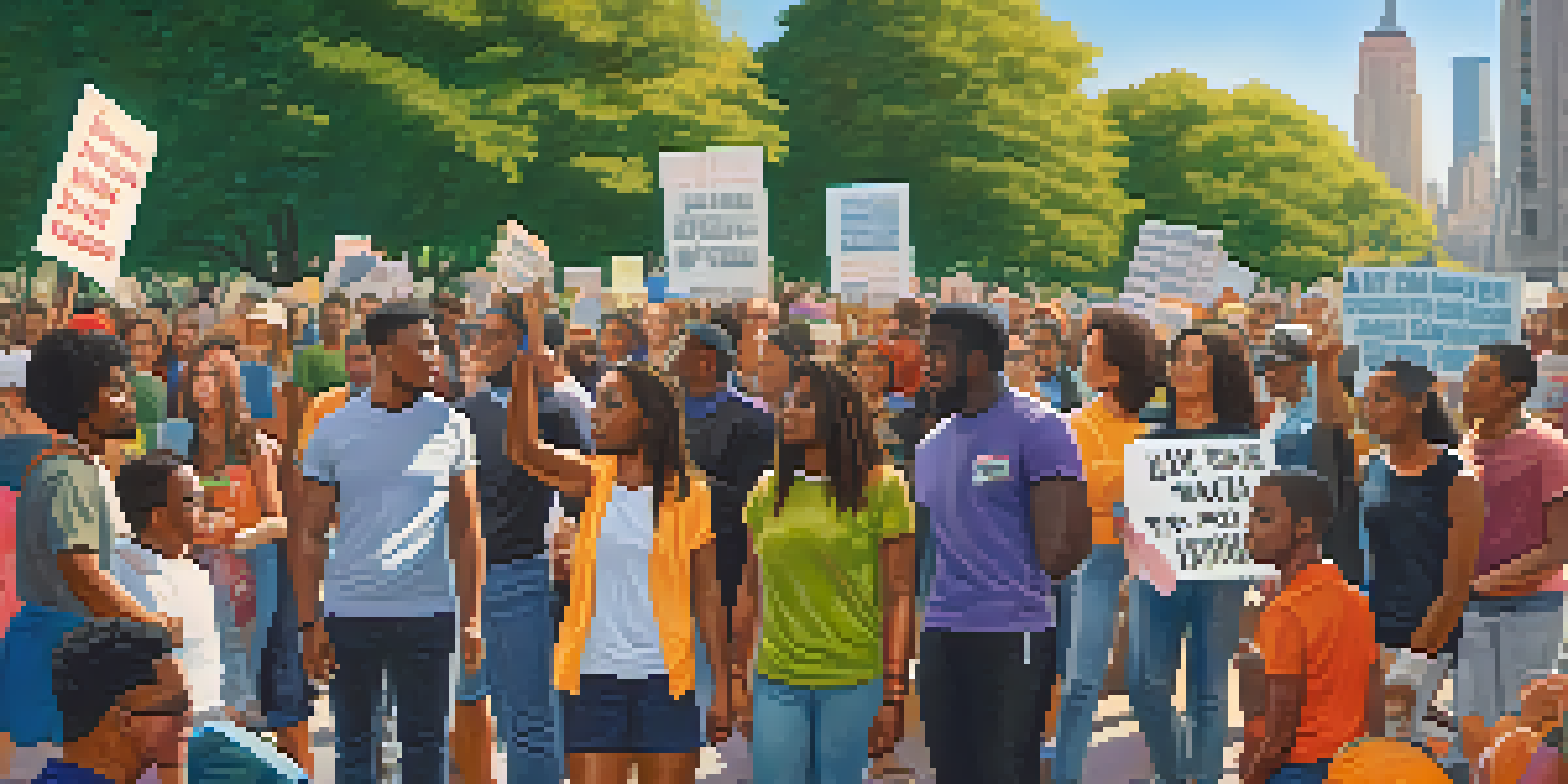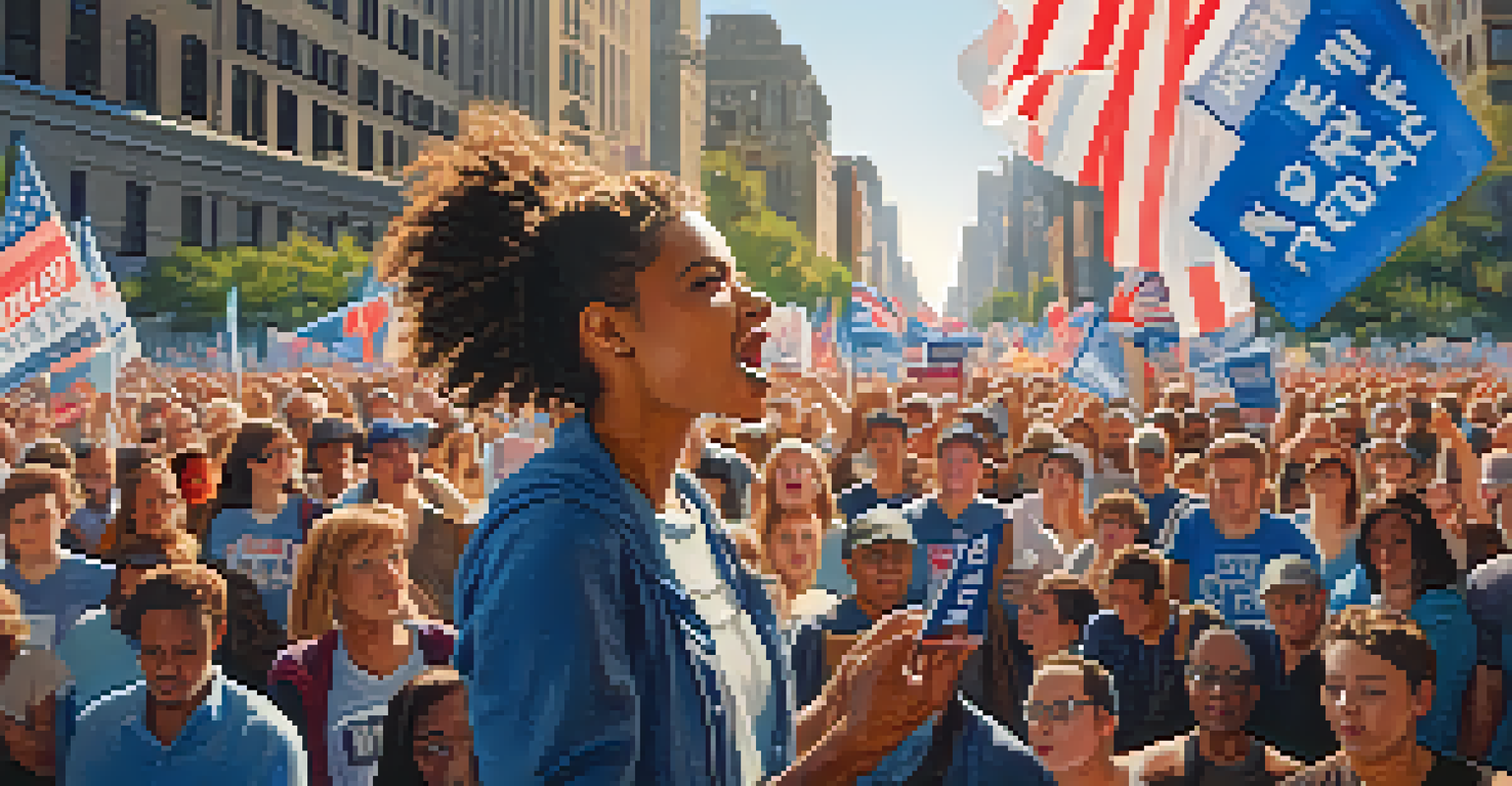Social Media's Role in NYC Youth Activism and Mobilization

The Rise of Social Media as a Powerful Tool
In recent years, social media has transformed how we communicate and organize. For the youth in New York City, platforms like Instagram, Twitter, and TikTok have become vital in rallying support and spreading awareness. These platforms allow young activists to share their stories, engage with their peers, and mobilize for causes that matter to them.
Social media is not just a tool for communication; it's a catalyst for change.
Gone are the days when organizing a protest meant printing flyers and passing them around. Today, a single post can reach thousands in minutes, making it easier for youth to connect with like-minded individuals. This instant communication fosters a sense of community and urgency, encouraging more young people to get involved in activism.
Moreover, social media allows for a diverse representation of voices. Whether it’s through hashtags, videos, or live streams, youth can share their unique perspectives and experiences, amplifying their message and helping to create a more inclusive dialogue around social issues.
Notable NYC Youth Movements Fueled by Social Media
Several significant movements in New York City have gained traction thanks to social media. For example, the March for Our Lives, organized by students after the tragic Parkland shooting, utilized platforms like Twitter and Instagram to mobilize thousands. NYC youth took to the streets, advocating for gun reform and safety in schools, showcasing the potential of online organization.

Similarly, the Black Lives Matter movement saw a surge in youth participation during the summer of 2020. Social media played a crucial role in sharing information about protests, resources, and ways to support the cause. Young activists utilized these platforms to educate others and share their experiences, making the movement more relatable and impactful.
Social Media Empowers Youth Activism
Platforms like Instagram and Twitter enable young activists in NYC to organize, share stories, and mobilize for important causes.
These examples demonstrate that social media isn't just a tool for communication; it's a catalyst for change. By harnessing the power of their online presence, NYC youth are not only influencing local conversations but are also contributing to global discussions on justice and equality.
Building Community Through Online Platforms
One of the most significant advantages of social media is its ability to foster community. Young activists in NYC are leveraging their platforms to create safe spaces for discussion and collaboration. Online groups and forums allow for the exchange of ideas, strategies, and support, breaking down geographical barriers.
The power of youth is the commonwealth for the entire world.
These virtual communities often translate into real-world action. For instance, after connecting online, many young advocates organize local meetups, workshops, and events that deepen their commitment to their causes. This blend of online and offline activism enhances engagement and strengthens their network.
Furthermore, these communities can provide emotional support. Activism can be exhausting and overwhelming, but through social media, youth can share their struggles and triumphs. This shared experience builds resilience and encourages individuals to keep pushing forward in their efforts.
The Role of Influencers in NYC Youth Activism
Influencers play a pivotal role in shaping the narrative around youth activism in NYC. Many young people look up to these figures for inspiration and guidance, as they often have large followings and can amplify important messages. When an influencer advocates for a cause, it can significantly increase awareness and engagement.
For instance, when popular figures share their experiences or promote events, it can lead to a surge in participation. This phenomenon was evident during climate strikes, where influencers encouraged their followers to join demonstrations. Their reach can inspire action and motivate those who might have otherwise remained passive.
Influencers Shape Activism Narratives
Influencers can significantly enhance awareness and involvement in youth activism by sharing their experiences and promoting events.
However, it’s essential for influencers to approach activism authentically. Followers can quickly spot inauthenticity, which can lead to backlash. Therefore, it's crucial for influencers to align their messages with genuine beliefs and actions, ensuring they contribute positively to the causes they promote.
Challenges of Social Media Activism
While social media provides numerous benefits for youth activism, it also presents challenges. One significant issue is the prevalence of misinformation. With the rapid spread of information, it’s easy for false narratives to take root, potentially undermining genuine efforts and misinforming the public.
Additionally, the digital landscape can sometimes foster a culture of performative activism. Some individuals may engage in activism online without taking meaningful actions offline. This can dilute the impact of real, dedicated efforts and create a false sense of accomplishment.
Lastly, the emotional toll of online activism is a critical consideration. Constant exposure to distressing news and heated debates can lead to burnout and mental health struggles. It’s essential for young activists to prioritize self-care and balance their online engagements with offline activities to maintain their passion and effectiveness.
The Future of Youth Activism in NYC
As social media continues to evolve, so will its role in youth activism in New York City. Emerging platforms and technologies may provide new opportunities for engagement and mobilization. Young activists will likely adapt and innovate, utilizing whatever tools are at their disposal to effect change.
Moreover, as digital literacy improves, youth will become more adept at navigating challenges like misinformation and performative activism. This growth can lead to more informed and effective movements, fostering a new generation of advocates who are both passionate and strategic.
Challenges of Online Activism Persist
Despite its benefits, social media activism faces challenges such as misinformation, performative activism, and emotional burnout.
Ultimately, the future of youth activism in NYC looks promising. With their creativity, resilience, and ability to harness the power of social media, young activists are poised to play a crucial role in shaping the social landscape for years to come.
Conclusion: The Lasting Impact of Social Media Activism
The intersection of social media and youth activism in New York City has created a dynamic landscape for change. As young people continue to leverage these platforms, they not only amplify their voices but also inspire others to join the fight for justice and equality. The ability to connect, organize, and mobilize is more powerful than ever.
While challenges exist, the resilience and creativity of today’s youth suggest that they are well-equipped to navigate this complex environment. Their commitment to causes they care about, paired with the tools of social media, will undoubtedly lead to lasting change in their communities.

As we move forward, it's essential to recognize the significance of these young voices and support their efforts. By doing so, we contribute to a brighter future where activism thrives and social justice becomes a shared priority for all.